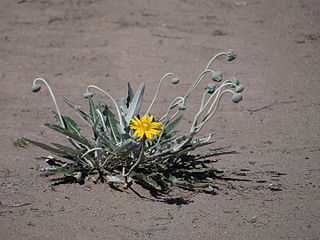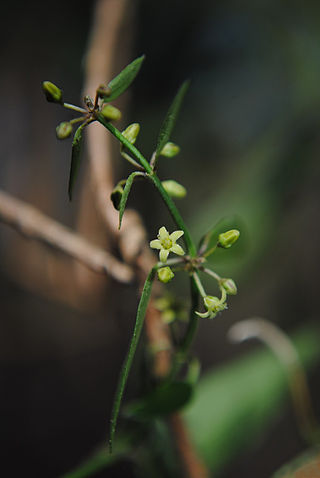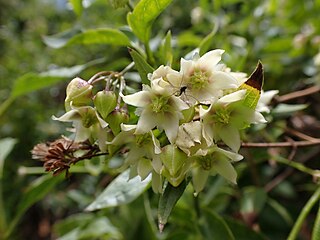
The Asclepiadoideae are a subfamily of plants in the family Apocynaceae. Formerly, they were treated as a separate family under the name Asclepiadaceae, e.g. by APG II, and known as the milkweed family.

Nothoscordum is a genus of New World plants in the onion tribe within the Amaryllis family. It is probably paraphyletic. The genus is native to North, Central and South America, though a few species have become naturalized in various parts of the Old World.

Cynanchum is a genus of about 300 species including some swallowworts, belonging to the family Apocynaceae. The taxon name comes from Greek kynos and anchein, hence the common name for several species is dog-strangling vine. Most species are non-succulent climbers or twiners. There is some evidence of toxicity.

Anredera is a genus of plants native to Latin America, the West Indies, Texas, and Florida. Some are naturalized in other regions. Most of them evergreen vines of dry scrubland and thickets. Members of the genus are commonly known as Madeira vines. At least one species, A. cordifolia bears edible roots or tubers and leaves similar to those of Basella alba. The same species has become an invasive plant in many tropical and subtropical regions outside its natural range.

Oxypetalum is a genus of flowering plants in the family Apocynaceae, first described with this name in 1810. The genus is native to South America.

Matelea is a genus of flowering plants in the family Apocynaceae. It contains about 200 species, which are commonly known as milkvines. Some people consider Chthamalia to be a synonym to or a subgenus of Matelea.

Sarcostemma is a formerly recognized genus of flowering plants in the dogbane family, Apocynaceae, first described as a genus in 1810. The name is derived from the Greek words σαρκὸς (sarkos), meaning "flesh," and στέμμα (stemma), meaning "garland". Members of the genus were known generally as climbing milkweeds or caustic bushes. The genus Sarcostemma has been shown to be nested within the genus Cynanchum, and in 2012 Sarcostemma was put into synonymy with Cynanchum.

Vincetoxicum is a genus of plants in the family Apocynaceae. Although the species in Vincetoxicum have sometimes been included in Cynanchum, chemical and molecular evidence shows that Vincetoxicum is more closely related to Tylophora, now included in Vincetoxicum. The generic name means "poison-beater" in Botanical Latin because of the plants' supposed antidotal effects against snakebite.

Ennealophus is a genus of perennial, herbaceous and bulbous plants in the family Iridaceae. It consists in five species distributed from Ecuador to Northern Brazil and Northwest Argentina. The genus name is derived from the Greek words ennea, meaning "nine", and lophus, meaning "crest".

Citharexylum is a genus of flowering plants in the verbena family, Verbenaceae. It contains shrub and tree species commonly known as fiddlewoods or zitherwoods. They are native to the Americas, ranging from southern Florida and Texas in the United States to Argentina. The highest diversity occurs in Mexico and the Andes. The generic name is derived from the Greek words κιθάρα (kithara), meaning "lyre", and ξύλον (xylon), meaning "wood," referring to the use of the wood in the sounding boards of string instruments. Several species, especially C. caudatum and C. spinosum, are cultivated as ornamentals.
- Citharexylum affineD.Don - from northern Mexico to Nicaragua
- Citharexylum alainiiMoldenke - Dominican Republic
- Citharexylum albicauleTurcz. - Cuba
- Citharexylum altamiranumGreenm. - northeastern Mexico
- Citharexylum andinumMoldenke - Bolivia, Jujuy Province of Argentina
- Citharexylum argutedentatumMoldenke - Peru
- Citharexylum berlandieriB.L. Rob. - from Texas to Oaxaca - Berlandier's fiddlewood, Tamaulipan fiddlewood
- Citharexylum bourgeauanumGreenm. - Veracruz, Oaxaca
- Citharexylum brachyanthum(A.Gray ex Hemsl.) A.Gray - Texas, Coahuila, Nuevo León - Boxthorn fiddlewood, Mexican fiddlewood
- Citharexylum bullatumMoldenke - Colombia
- Citharexylum calvumMoldenke - Quintana Roo
- Citharexylum caudatumL. - southern Mexico, West Indies, Central America, Colombia, Peru - Juniper berry
- Citharexylum chartaceumMoldenke - Peru, Ecuador
- Citharexylum cooperiStandl. - Costa Rica, Panama, Guatemala
- Citharexylum costaricenseMoldenke - Costa Rica, Nicaragua, Honduras
- Citharexylum crassifoliumGreenm - Chiapas, Belize, Guatemala, Honduras
- Citharexylum daniraeLeón de la Luz & F.Chiang - Revillagigedo Islands of Baja California
- Citharexylum decorumMoldenke - Colombia, Venezuela
- Citharexylum dentatumD.Don - Peru
- Citharexylum discolorTurcz. - Cuba, Hispaniola
- Citharexylum donnell-smithiiGreenm. - Oaxaca, Chiapas, Central America
- Citharexylum dryanderaeMoldenke - Colombia, Venezuela, Peru, Ecuador
- Citharexylum ekmaniiMoldenke - Cuba
- Citharexylum ellipticumMoc. & Sessé ex D.Don - Veracruz, Campeche, Tabasco; naturalized in Cuba + Cayman Islands
- Citharexylum endlichiiMoldenke - northeastern Mexico
- Citharexylum flabellifoliumS.Watson - Sonora, Baja California
- Citharexylum flexuosum(Ruiz & Pav.) D.Don - Bolivia, Peru
- Citharexylum fulgidumMoldenke - Veracruz, northeastern Mexico
- Citharexylum gentryiMoldenke - Ecuador
- Citharexylum glabrum(S.Watson) Greenm - Oaxaca
- Citharexylum glazioviiMoldenke - eastern Brazil
- Citharexylum grandiflorumAymard & Rueda - Ecuador
- Citharexylum guatemalense(Moldenke) D.N.Gibson - Guatemala, Nicaragua
- Citharexylum herreraeMansf. - Peru
- Citharexylum hexangulareGreenm. - from northern Mexico to Costa Rica
- Citharexylum hidalgenseMoldenke - Mexico
- Citharexylum hintoniiMoldenke - México State
- Citharexylum hirtellumStandl. - from Veracruz to Panama
- Citharexylum ilicifoliumKunth - Bolivia, Peru, Ecuador
- Citharexylum iltisiiMoldenke - Peru
- Citharexylum × jamaicenseMoldenke - Jamaica, Haiti, Puerto Rico (C. caudatum × C. spinosum)
- Citharexylum joergensenii(Lillo) Moldenke - Argentina, Bolivia
- Citharexylum karsteniiMoldenke - Colombia, Venezuela
- Citharexylum kerberiGreenm. - Veracruz
- Citharexylum kobuskianumMoldenke - Peru
- Citharexylum krukoviiMoldenke - eastern Brazil
- Citharexylum kunthianumMoldenke - Colombia, Venezuela, Ecuador
- Citharexylum laetumHiern - southern Brazil
- Citharexylum laurifoliumHayek - Bolivia, Peru
- Citharexylum lemsiiMoldenke - Guanacaste Province in Costa Rica
- Citharexylum × leonisMoldenke - Cuba (C. caudatum × C. tristachyum)
- Citharexylum ligustrifolium(Thur. ex Decne.) Van Houtte - Mexico
- Citharexylum lojenseMoldenke - Ecuador
- Citharexylum lucidumCham. & Schltdl. - Mexico
- Citharexylum lycioidesD.Don - Mexico
- Citharexylum macradeniumGreenm. - Panama, Costa Rica
- Citharexylum macrochlamysPittier - Panama, Colombia
- Citharexylum macrophyllumPoir. - Colombia, Venezuela, Ecuador, Guianas, northwestern Brazil
- Citharexylum matheanumBorhidi & Kereszty - Cuba
- Citharexylum matudaeMoldenke - Chiapas
- Citharexylum mexicanumMoldenke - Veracruz, Puebla, Oaxaca
- Citharexylum microphyllum(DC.) O.E.Schulz - Hisipaniola
- Citharexylum mirifoliumMoldenke - Colombia, Venezuela
- Citharexylum mocinoiD.Don - Mexico, Central America
- Citharexylum montanumMoldenke - Colombia, Ecuador
- Citharexylum montevidense(Spreng.) Moldenke - Brazil, Argentina, Paraguay, Uruguay
- Citharexylum myrianthumCham. - Brazil, Argentina, Paraguay
- Citharexylum obtusifoliumKuhlm - Espírito Santo
- Citharexylum oleinum Moldenke - Mexico
- Citharexylum ovatifoliumGreenm. - Mexico
- Citharexylum pachyphyllumMoldenke - Peru
- Citharexylum pernambucenseMoldenke - eastern Brazil
- Citharexylum poeppigiiWalp. - Colombia, Venezuela, Ecuador, Bolivia, Peru, Brazil
- Citharexylum punctatumGreenm. - Bolivia, Peru
- Citharexylum quercifoliumHayek - Peru
- Citharexylum quitenseSpreng. - Ecuador
- Citharexylum racemosumSessé & Moc. - Mexico
- Citharexylum reticulatumKunth - Ecuador, Peru
- Citharexylum rigidum(Briq.) Moldenke - Paraguay, southern Brazil
- Citharexylum rimbachiiMoldenke - Ecuador
- Citharexylum roseiGreenm. - Mexico
- Citharexylum roxanaeMoldenke - Baja California
- Citharexylum scabrumMoc. & Sessé ex D.Don - northern Mexico
- Citharexylum schottiiGreenm. - southern Mexico, Central America
- Citharexylum schulziiUrb. & Ekman - Hispaniola
- Citharexylum sessaeiD.Don - Mexico
- Citharexylum shreveiMoldenke - Sonora
- Citharexylum solanaceumCham. - southern Brazil
- Citharexylum spinosumL. – Spiny fiddlewood - West Indies, Panama, Venezuela, the Guianas; naturalized in India, Mozambique, Fiji, Bermuda
- Citharexylum stenophyllumUrb. & Ekman - Haiti
- Citharexylum steyermarkiiMoldenke - Veracruz, Chiapas, Guatemala
- Citharexylum suberosumLoes. ex Moldenke - Cuba
- Citharexylum subflavescensS.F.Blake - Colombia, Venezuela, Ecuador, Peru
- Citharexylum subthyrsoideumPittier - Colombia, Venezuela
- Citharexylum subtruncatumMoldenke - northwestern Brazil
- Citharexylum sulcatumMoldenke - Colombia
- Citharexylum svensoniiMoldenke - Ecuador
- Citharexylum teclenseStandl. - El Salvador
- Citharexylum ternatumMoldenke - Cuba
- Citharexylum tetramerumBrandegee - Valle de Tehuacán-Cuicatlán in Mexico
- Citharexylum tristachyumTurcz. – Threespike Fiddlewood - Cuba, Jamaica, Leeward Islands
- Citharexylum uleiMoldenke - Colombia, Peru, northwestern Brazil
- Citharexylum vallenseMoldenke - Colombia
- Citharexylum venezuelenseMoldenke - Venezuela
- Citharexylum weberbaueriHayek - Peru

Trichocline is a genus of Australian and South American plants in the tribe Mutisieae within the family Asteraceae. It consists of one species from Australia (T. spathulata) and twenty-three from South America.

Flourensia is a genus of flowering plants in the family Asteraceae. It contains subshrubs and shrubs, which are commonly known as tarworts. They are found in the southwestern United States, Mexico, Central America, and South America. The genus name honours French physiologist Jean Pierre Flourens (1794–1867).

Funastrum is a genus of flowering plant now in the family Apocynaceae. The name is derived from the Latin word funis, meaning "rope", and astrum, alluding to the twining stems. Members of the genus are commonly known as twinevines.

Orthosia is a genus of plants in the family Apocynaceae, first described as a genus in 1844.

Morrenia is a genus of flowering plants in the family Apocynaceae, first described as a genus in 1838. It is native to South America.

Jobinia is a genus of flowering plants of the family Apocynaceae first described in 1885. It is native to South America and Central America.

Macroscepis is a genus of plants in the family Apocynaceae, first described as a genus in 1819. It is native to Latin America and the West Indies.

Ruehssia is a genus of plants in the family Apocynaceae. It is also in the Asclepiadoideae subfamily and Marsdenieae tribe.

















